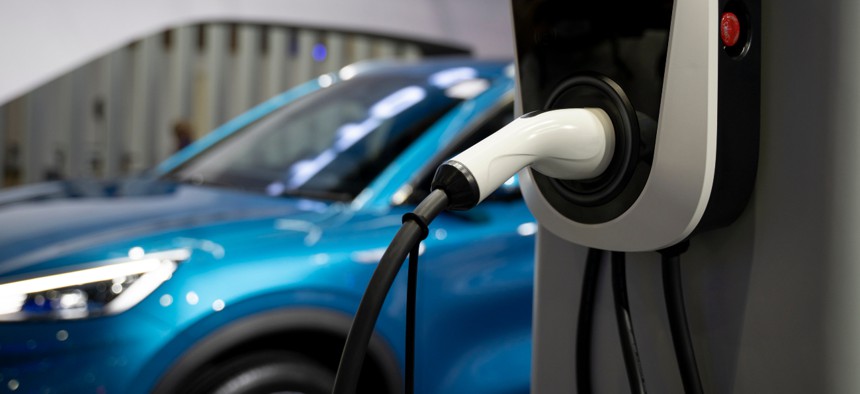Federal agencies plan to spend $770M ramping up their electric vehicle usage this year
The Biden administration has ambitious goals to electrify the federal fleet, but many obstacles remain.
The federal government is planning to spend $770 million on zero-emission vehicles and charging stations in fiscal 2023 as agencies begin ramping up to meet President Biden’s ambitious timeline to phase out gas-guzzling cars and trucks.
Agencies plan to buy 9,500 ZEVs in fiscal 2023, according to a Government Accountability Office report, which federal fleet offices project will cost $470 million. That marks a $200 million increase over what it would cost agencies to buy the cheapest available vehicles. They will spend another $300 million on 8,500 charging stations, provided they have the funding to do so.
Officials across government are implementing aggressive plans to electrify their fleets after Biden ordered agencies to stop purchasing emission cars, trucks and vans by 2027 and to cease buying any internal combustion engine non-tactical vehicles at all by 2035. GAO cautioned that while agencies are taking several steps to better prepare themselves for the shift, there remain many challenges to meeting the targets the Biden administration has created.
In fiscal 2022, agencies fell short of their ZEV goals in part due to inadequate funding. Meeting targets is also contingent on the availability of mission-appropriate vehicles from manufacturers. The Transportation Department, for example, has run into issues with limited quantities of electric vehicles available. It had hoped to purchase 430 EVs in fiscal 2022, but only received 292 after manufacturers canceled some of the orders. The Energy Department estimated one-in-four EV orders by federal agencies in fiscal 2022 were canceled. Other agencies, such as Customs and Border Protection, said no current electric vehicle technology can support its needs in extreme environments at the border.
Some agencies expressed concerns about electrical capacities at their facilities. The White House has acknowledged the issue, with its Council on Environmental Quality telling agencies to reach out to utilities to request infrastructure upgrades that could take years to install. Upgrading facilities with charging ports could cost hundreds of thousands of dollars, GSA said, with even straightforward installations coming with a price tag of around $50,000. GSA plans to issue guidance to help agencies navigate negotiations with landlords as they look to install charging stations on leased property.
Agencies are aiming to accelerate their ZEV purchasing quickly. Next fiscal year, agencies are planning to buy 15,000 electric vehicles, a figure that will climb gradually until they are purchasing 30,000 by 2027.
Agencies have so far conducted 550 site assessments for charging stations, GAO found, and plan to review another 1,800. Energy has instructed agencies to plan for their charging needs five years out and agencies have plans to install 76,000 ports by 2027.
GAO noted Biden’s policy “represents a significant transformation in the federal government’s approach to vehicle procurement,” as just 260 of the 45,000 vehicles it replaced or acquired in fiscal 2021 were electric. In a report last year, GAO found that less than 1% of the federal fleet was electric and it had only 4,000 charging ports of the 100,000 it will eventually need to meet Biden's goal. Ramping up the purchases will require not just funding and availability of the vehicles, the auditors said, but a “shift in perceptions about their capability to adequately meet mission needs.”
To meet the ambitious targets, agencies have set up ZEV teams and have begun offering employees training on acquisition and driving. The education programs involve preparing fleet managers to assess the benefits and tradeoffs of electric vehicles, advocating agencies' work with local utilities, offering lessons on how to drive ZEVs to maximize their batteries and setting up pilot programs to familiarize the workforce with the new cars.
Energy has issued a 15-step roadmap for agencies to implement as they prepare for ZEV acquisition, which will include agencies submitting annual targets that must be approved by the White House’s CEQ. Energy, CEQ, the Office of Management and Budget and the General Services Administration have developed a tool for agencies to measure which vehicles would be best to replace with an electric alternative. Agencies are using telematics to track driving data on all new vehicles and will do so on all existing leased vehicles by 2026.
A recent analysis found the federal government could save $6 billion over the next 15 years by converting its fleet to electric vehicles, even after accounting for the significant upfront costs.
The U.S. Postal Service, which maintains its own fleet separate from GSA of more than 200,000 vehicles, is currently in the process of replacing most of its vans and trucks. After a drawn out fight among postal management, the Biden administration, lawmakers and environmental groups over how many of those vehicles should be electric, Congress intervened and provided $3 billion for USPS to purchase a higher rate of EVs and charging stations. Postmaster General Louis DeJoy announced 75% of the vehicles USPS will purchase will be electric, following negotiations with the White House. USPS will begin installing charging stations this year and will initially purchase 66,000, one for each of the EVs it plans to buy over the next several years.








